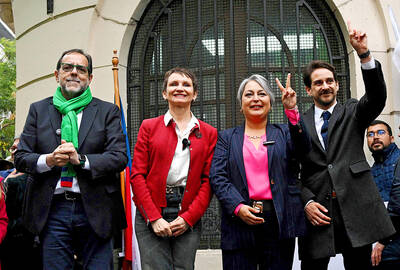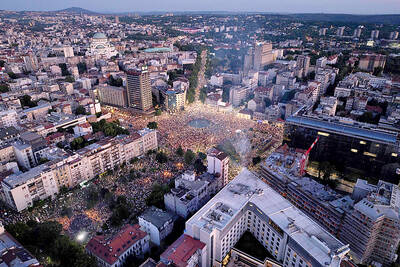With tree-covered slopes that rise to a pointed summit, the mountain overlooking the Bosnian town of Visoko resembles any other ordinary hillside in the Balkan state.
Yet thousands of yearly visitors — including stars like Serbian tennis champion Novak Djokovic — do not see it that way.
Despite scientists’ efforts to debunk the claims, large numbers of people still believe that the hill is an ancient pyramid with magical healing powers.

Photo: AFP
Djokovic, who is known for his new-age spiritual interests, has made two trips this year, hailing the site as a “paradise on Earth.”
The mountain is now home to a controversial pyramid park, the work of Semir Osmanagic, a 60-year-old self-styled explorer who “discovered” the site just outside of Sarajevo in 2005.
“I saw this hill covered with fir trees and vegetation, its slopes perfectly oriented towards the cardinal points,” Osmanagic, wearing a leather jacket and Indiana Jones-style hat, told reporters on a recent weekend while leading a tour group through the site.
“It was obvious to me that it was not a natural hill, but the construction” of a “technologically superior civilization,” he said, adding that it is the “largest and oldest pyramid ever built.”
Archeologists have disputed this theory, saying that the hill is a natural geological structure.
In a letter to Bosnian authorities in 2006, European archeologists denounced the “support” given to a “cruel hoax on an unsuspecting public” that “has no place in the world of genuine science.”
This did not prevent Osmanagic from carrying out “archeological excavations” on the hill with hundreds of volunteers from abroad.
He bought a piece of surrounding land, which includes a network of tunnels that he says emit a special “energy” force, and a few years later opened the park through his Bosnian Pyramid of the Sun foundation.
Today, the park is buzzing with visitors, who have come in even higher numbers since two recent trips from Djokovic.
In July and last month, Djokovic made pilgrimages to the park and invited “all athletes” to take advantage of the healthy “oxygen” levels.
“I know there are many doubts and dilemmas about the authenticity” of the place, he told reporters last month.
However, “in order to fully understand what is going on here ... you have to come,” he said.
After a quiet spring subdued by the COVID-19 pandemic, weekend crowds are back at the park, consisting mostly of visitors from the region.
“The beginning of the season was catastrophic, but since Djokovic has been here, it’s been a joy,” says Nermin Alihodzic, 47, who sells tourists colorful mini-pyramids and pieces of quartz.
While the government stopped backing the park more than a decade ago, local authorities have helped finance the construction of roads, parking lots and other infrastructure to encourage tourists.
A 5 euro (US$5.94) entry fee for the whole park includes access to the tunnel network that Osmanagic claims emit healing electromagnetic waves.
In his tour, Osmanagic takes groups down to the chambers, urging them to hold their hands over a smooth rock and feel the “energy” rising.
Dzenana Halepovic, a 67-year-old visitor from Sarajevo, is a frequent visitor.
In the tunnels “I feel good, I breathe well, I feel light. I simply feel like I’m receiving energy there,” she said.
For Enver Imamovic, a professor emeritus of archeology at the University of Sarajevo, the project is a scam.
The tunnels are likely “remnants of an ancient gold mine,” while stones on the hillside, which believers consider to be the building blocks of the pyramid, are “nothing more than natural geological formations,” he told reporters. “Everything that is said about the pyramids is absolutely unacceptable.”
Osmanagic has also been promoting the site as a place to “boost immunity” during the pandemic.
While he says that no cures are guaranteed, he cites other alleged miracles in which people have been healed of hypertension, diabetes or even cancer after a trip to the tunnels.
In a country with a weak health system whose shortcomings have been exposed by the pandemic, many are drawn to alternative medicine.
Emina Kavaz, 53, said that she chooses the “pyramids” over taking medicine for her asthma.
“I used to come every Saturday to go through the tunnels for between 40 and 60 minutes,” she said. “The price ... is insignificant compared to the result obtained.”

Drug lord Jose Adolfo Macias Villamar, alias “Fito,” was Ecuador’s most-wanted fugitive before his arrest on Wednesday, more than a year after he escaped prison from where he commanded the country’s leading criminal gang. The former taxi driver turned crime boss became the prime target of law enforcement early last year after escaping from a prison in the southwestern port of Guayaquil. Ecuadoran President Daniel Noboa’s government released “wanted” posters with images of his face and offered US$1 million for information leading to his capture. In a country plagued by crime, members of Fito’s gang, Los Choneros, have responded with violence, using car

Two former Chilean ministers are among four candidates competing this weekend for the presidential nomination of the left ahead of November elections dominated by rising levels of violent crime. More than 15 million voters are eligible to choose today between former minister of labor Jeannette Jara, former minister of the interior Carolina Toha and two members of parliament, Gonzalo Winter and Jaime Mulet, to represent the left against a resurgent right. The primary is open to members of the parties within Chilean President Gabriel Boric’s ruling left-wing coalition and other voters who are not affiliated with specific parties. A recent poll by the

TENSIONS HIGH: For more than half a year, students have organized protests around the country, while the Serbian presaident said they are part of a foreign plot About 140,000 protesters rallied in Belgrade, the largest turnout over the past few months, as student-led demonstrations mount pressure on the populist government to call early elections. The rally was one of the largest in more than half a year student-led actions, which began in November last year after the roof of a train station collapsed in the northern city of Novi Sad, killing 16 people — a tragedy widely blamed on entrenched corruption. On Saturday, a sea of protesters filled Belgrade’s largest square and poured into several surrounding streets. The independent protest monitor Archive of Public Gatherings estimated the

Irish-language rap group Kneecap on Saturday gave an impassioned performance for tens of thousands of fans at the Glastonbury Festival despite criticism by British politicians and a terror charge for one of the trio. Liam Og O hAnnaidh, who performs under the stage name Mo Chara, has been charged under the UK’s Terrorism Act with supporting a proscribed organization for allegedly waving a Hezbollah flag at a concert in London in November last year. The rapper, who was charged under the anglicized version of his name, Liam O’Hanna, is on unconditional bail before a further court hearing in August. “Glastonbury,